Drainage patterns: Discordant drainage patterns & Concordant Drainage Patterns
Table of Contents
Drainage basin
- Other terms that are used to describe drainage basins are catchment, catchment area, catchment basin, drainage area, river basin, and water basin.
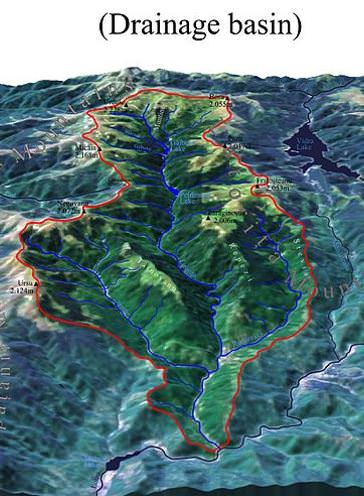
- The drainage basin includes both the streams and rivers and the land surface.
- The drainage basin acts as a funnel by collecting all the water within the area covered by the basin and channeling it to a single point.
- In closed (“endorheic”) drainage basins the water converges to a single point inside the basin, known as a sink, which may be a permanent lake [Lake Aral], dry lake [some desert lakes], or a point where surface water is lost underground [sink holes in Karst landforms]. Other Examples: Lake Chad [Africa], Dead Sea etc.
Drainage Divide
- Adjacent drainage basins are separated from one another by a drainage divide. Drainage divide is usually a ridge or a high platform.
- Drainage divide is conspicuous in case of youthful topography [Himalayas] and it is not well marked in plains [Ganga plains] and senile topography [old featureless landforms – Rolling plateaus of Peninsular region though which South Indian rivers flow].
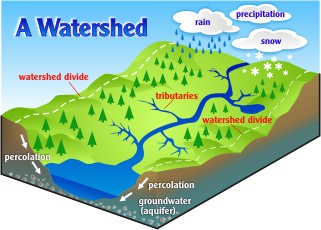
Some important drainage basins across the world
This is Wiki stuff. So can’t guarantee accuracy.
Basin | Type | Continent | Drains to |
Basin Area
|
| Amazon River | Primary River | South America | Atlantic Ocean | 6,144,727 |
| Hudson Bay | Mediterranean sea | North America | Atlantic Ocean | 3,861,400 |
| Congo River | Primary River | Africa | Atlantic Ocean | 3,730,474 |
| Caspian Sea | Lake | Asia/Europe | (endorheic basin == not outlet) | 3,626,000 |
| Nile River | Primary River | Africa | Mediterranean Sea | 3,254,555 |
| Mississippi-Missouri River | Primary River | North America | Gulf of Mexico | 3,202,230 |
| Lake Chad | Lake | Africa | n/a (endorheic basin) | 2,497,918 |
| Black Sea | Mediterranean sea | multiple | Mediterranean Sea | 2,400,000 |
| Niger River | Primary River | Africa | Atlantic Ocean | 2,261,763 |
| Yangtze River (Chang Jiang) | Primary River | Asia | Pacific Ocean | 1,722,155 |
| Baltic Sea | Mediterranean sea | Europe | Atlantic Ocean[4] | 1,700,000 |
| Ganges–Brahmaputra | Primary River | Asia | Bay of Bengal | 1,621,000 |
| Indus River | Primary River | Asia | Arabian Sea | 1,081,733 |
Difference between a River Basin and a Watershed
- Both river basins and watersheds are areas of land that drain to a particular water body, such as a lake, stream, river or estuary.
- In a river basin, all the water drains to a large river. The term watershed is used to describe a smaller area of land that drains to a smaller stream, lake or wetland. There are many smaller watersheds within a river basin.
- Example: watershed of Yamuna + water shed of Chambal + watershed of Gandak + …. = Drainage basin of Ganga.
Drainage patterns
- Based on the shape and formation of river patters, there are different drainage patterns.
Discordant drainage patterns
- A drainage pattern is described as discordant if it does not correlate to the topology [surface relief features] and geology [geological features based on both Endogenetic movements and exogenetic movements] of the area.
- In simple words: In a discordant drainage pattern, the river follows its initial path irrespective of the changes in topography.
- Discordant drainage patterns are classified into two main types: antecedent and superimposed.
Antecedent Drainage or Inconsequent Drainage
- A part of a river slope and the surrounding area gets uplifted and the river sticks to its original slope, cutting through the uplifted portion like a saw [Vertical erosion or Vertical down cutting], and forming deep gorges: this type of drainage is called Antecedent drainage.
Example: Indus, Sutlej, Brahmaputra and other Himalayan rivers that are older than the Himalayas themselves. There are usually called as ANTECEDENT RIVERS.
Superimposed or Epigenetic (Discordant) or Superinduced Drainage
- When a river flowing over a softer rock stratum reaches the harder basal rocks but continues to follow the initial slope, it seems to have no relation with the harder rock bed. This type of drainage is called superimposed drainage.
- Usually, the drainage patterns (dendritic, trellis, etc.) are strongly influenced by the hardness and softness of the rock and patterns of faults or fractures.
- Sometimes, however, the land rises rapidly relative to the base level of the stream. This increases the gradient of the stream and therefore, gives the stream more erosive power.
- The stream has enough erosive power that it cuts its way through any kind of bedrock, maintaining its former drainage pattern.
- You get a situation, then, where the drainage pattern does not correspond to the hardness or softness of the bedrock or to the locations of faults and fractures.
- In other words, it is a drainage pattern which exhibits discordance with the underlying rock structure because it originally developed on a cover of rocks that has now disappeared due to denudation.
- Consequently, river directions relate to the former cover rocks and, as the latter were being eroded, the rivers have been able to retain their courses unaffected by the newly exposed structures.
The stream pattern is thus superposed on, or placed on structural features that were previously buried.
- The Damodar, the Subarnarekha, the Chambal, the Banas and the rivers flowing at the Rewa Plateau present some good examples of superimposed drainage.
- Examples: The Damodar, the Subarnarekha, the Chambal, the Banas and the rivers flowing at the Rewa Plateau, rivers of eastern USA and southern France.
- [In simple words, the river flow becomes independent of present Topography. It flows in its initial paths without being influenced by changing topography].
Antecedent Drainage == Cut through the newly formed landform and maintain the same path == Himalayan Rivers.
Superimposed Drainage == Cut deeper through the existing landform and maintain the same path == Some medium scale rivers of the Northern and Eastern peninsular India.
Antecedent Drainage == The soil formed is weak and it is easily eroded by the rivers.
Superimposed Drainage == The rivers have high erosive power so that they can cut through the underlying strata.
Usually, rivers in both these drainage types flow through a highly sloping surface.
Concordant Drainage Patterns
- A drainage pattern is described as concordant if it correlates to the topology and geology of the area.
- In simple words: In a concordant drainage pattern, the path of the river is highly dependent on the slope of the river and topography.
- Concordant drainage patterns are the most commonly found drainage patterns and are classified into many types.
Consequent Rivers
- The rivers which follow the general direction of slope are known as the consequent rivers.
- Most of the rivers of peninsular India are consequent rivers.
- For example, rivers like Godavari, Krishna and Cauvery, descending from the Western Ghats and flowing into the Bay of Bengal, are some of the consequent rivers of Peninsular India.
Subsequent Rivers
- A tributary stream that is eroded along an underlying belt of non-resistant rock after the main drainage pattern (Consequent River) has been established is known as a subsequent river.
- The Chambal, Sind, Ken, Betwa, Tons and Son meet the Yamuna and the Ganga at right angles. They are the subsequent drainage of the Ganga drainage system.
- These streams have generally developed after the original stream.
Dendritic or Pinnate Drainage Pattern
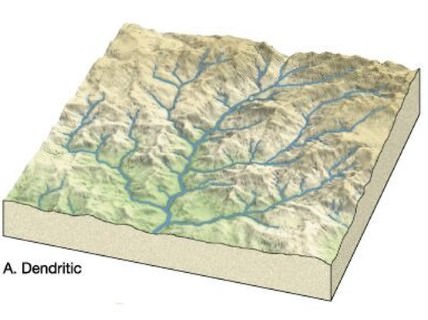
- This is an irregular tree branch shaped pattern.
- Drainage which is branching or ramifying (branch out or cause to branch out) thereby giving the appearance of a tree.
- A dendritic pattern develops in a terrain which has uniform lithology, and where faulting and jointing are insignificant.
- Examples: Indus, Godavari, Mahanadi, Cauvery, Krishna.
Trellis Drainage Pattern
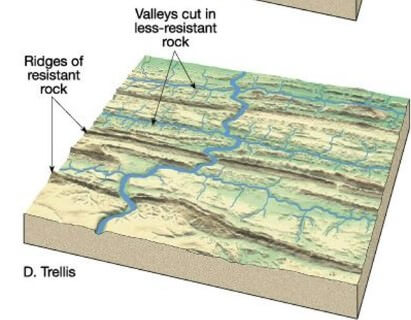
- In this type of pattern the short subsequent streams meet the main stream at right angles, and differential erosion through soft rocks paves the way for tributaries.
- Examples: The old folded mountains of the Singhbhum (Chotanagpur Plateau) and Seine and its tributaries in Paris basin (France) have a drainage of trellis pattern.
Angular Drainage Pattern
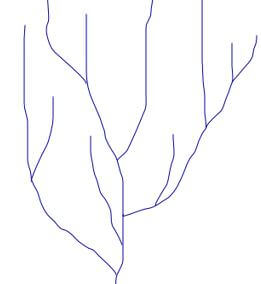
- The tributaries join the main stream at acute angles.
- This pattern is common in Himalayan foothill regions.
Rectangular Drainage Pattern
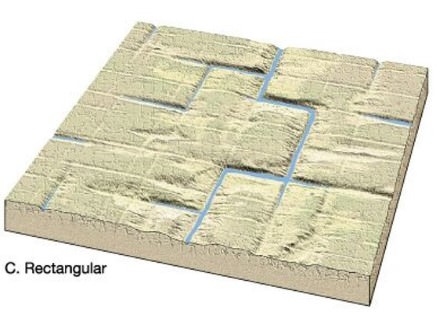
- The main stream bends at right angles and the tributaries join at right angles creating rectangular patterns.
- This pattern has a subsequent origin.
- Example: Colorado river (USA), streams found is the Vindhyan Mountains of India.
Radial Drainage Pattern
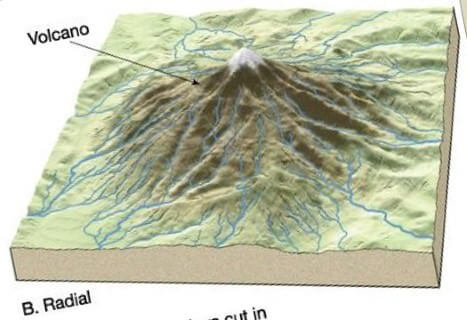
- The tributaries from a summit follow the slope downwards and drain down in all directions.
- Examples: Streams of Saurashtra region, Central French Plateau, Mt. Kilimanjaro.
- A good example of a radial drainage pattern is provided by the rivers originating from the Amarkantak Mountain.
- Rivers like Narmada, Son and Mahanadi originating from Amarkantak Hills flow in different directions and are good examples of radial pattern.
- Radial drainage patterns are also found/in the Girnar Hills (Kathiwar, Gujarat), and Mikir Hills of Assam.
Annular Drainage Pattern
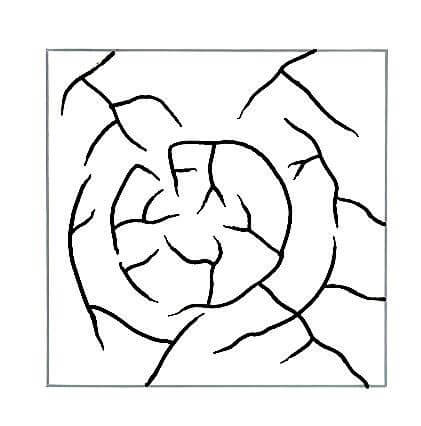
- When the upland has an outer soft stratum, the radial streams develop subsequent tributaries which try to follow a circular drainage around the summit.
- Example: Black Hill streams of South Dakota.
- This is not a very common drainage pattern in India. Some examples of this are however found in Pithoragarh (Uttarakhand), Nilgiri Hills in Tamil Nadu and Kerala.
Parallel Drainage Pattern
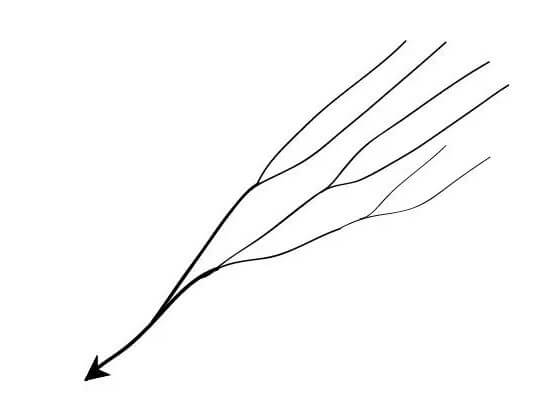
- The tributaries seem to be running parallel to each other in a uniformly sloping region.
- Example: Rivers of lesser Himalayas and The small and swift rivers originating in the Western Ghats that flow into Arabian Sea.
Centripetal Drainage Pattern
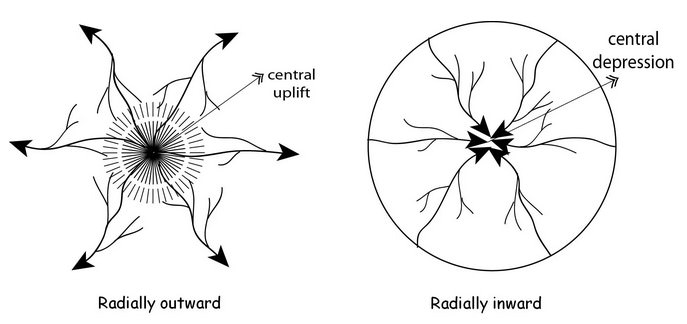
- In a low lying basin the streams converge from all sides.
- Examples: streams of Ladakh, Tibet, and the Baghmati and its tributaries in Nepal.
Deranged Drainage Pattern
- This is an uncoordinated pattern of drainage characteristic of a region recently vacated by an ice-sheet.
- This type of drainage is found in the glaciated valleys of Karakoram.
Barbed Drainage Pattern
- A pattern of drainage in which the confluence of a tributary with the main river is characterized by a discordant junction—as if the tributary intends to flow upstream and not downstream.
- This pattern is the result of capture of the main river which completely reverses its direction of flow, while the tributaries continue to point in the direction of former flow.
- The Arun River (Nepal), a tributary of the Kosi is an interesting example of barbed drainage pattern
.
No comments:
Post a Comment